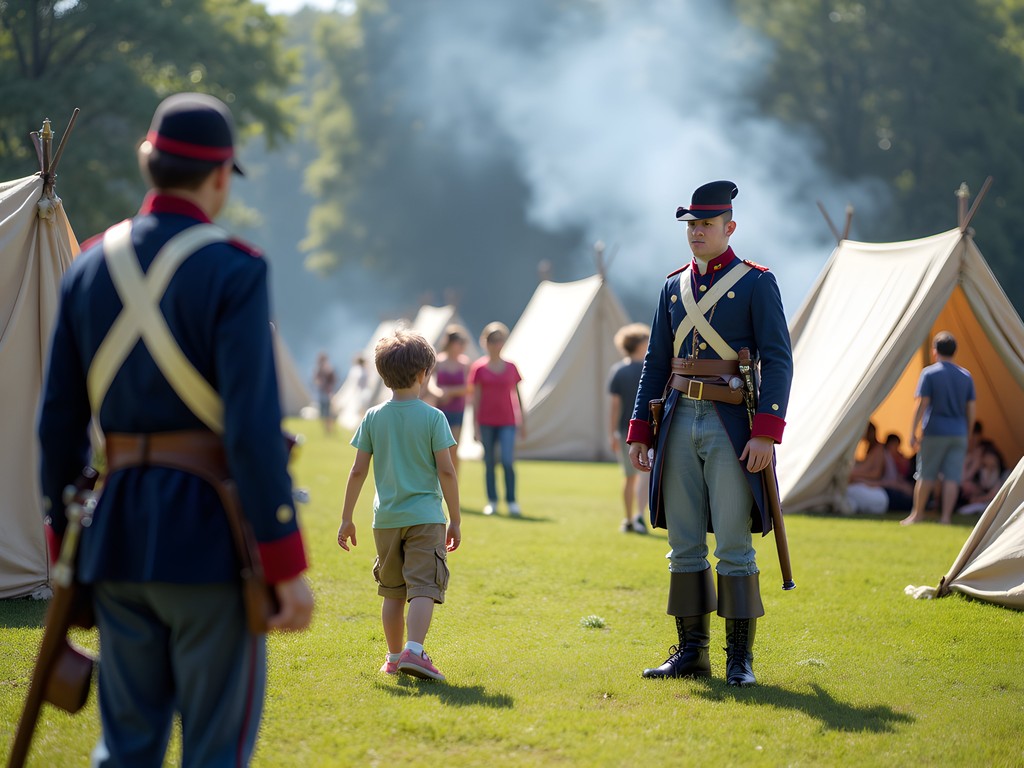Disclosure: This article contains affiliate links. We may earn a commission from purchases at no extra cost to you, which helps our travel content.
Standing at the edge of the Great Dismal Swamp, where escaped enslaved people once sought freedom through treacherous terrain, I felt the weight of history pressing against my judicial robes. Suffolk, Virginia may not headline most Civil War itineraries, but this overlooked gem offers families an accessible portal into our nation's complex past—a past that continues to shape our legal frameworks and social consciousness today. As someone who navigates the intersections of law, heritage, and environmental preservation professionally, I found Suffolk's battlefields to be profound classrooms under open sky.
Cedar Hill Cemetery: Where History Rests
My exploration of Suffolk's Civil War narrative began at Cedar Hill Cemetery, established in 1802 but particularly significant for its Confederate Monument and military burials. As someone who studies genealogy as passionately as legal precedents, I found myself tracing weathered inscriptions with my fingertips, reconstructing the stories of soldiers and civilians alike.
The cemetery contains a dedicated Confederate section where over 400 soldiers rest, many in unmarked graves. What struck me most was the juxtaposition of this solemn memorial against the knowledge that Suffolk changed hands between Union and Confederate forces multiple times during the war.
I spent a contemplative morning here, my foldable walking stick proving invaluable as I navigated the uneven terrain between grave markers. For families visiting, this site offers a tangible connection to history that textbooks simply cannot provide, though parents should prepare thoughtful context for younger visitors about the complex legacy of Confederate monuments in modern America.

💡 Pro Tips
- Visit early morning for peaceful reflection and better photography lighting
- Bring a notebook to record interesting epitaphs and family names for later research
- The cemetery office has maps highlighting Civil War-related graves
The Siege of Suffolk: Earthworks and Encampments
The 23-day Siege of Suffolk in April 1863 transformed this small Virginia town into a critical battleground. Today, remnants of earthworks and fortifications still dot the landscape, offering families a chance to walk where history unfolded. I recommend beginning at Riddick's Folly House Museum, which served as headquarters for Union General John Peck during the occupation.
The museum provides crucial context through artifacts and documents, but it's the preserved earthworks at sites like Fort Huger that truly transport visitors back to 1863. As I traced these defensive lines with my military history guidebook, I couldn't help but consider the legal implications of military occupation on civilian populations—a topic that still resonates in international law today.
For families with active children, these outdoor sites provide space to explore while learning. My nephew particularly enjoyed the Junior Civil War Historian program available through the Suffolk Visitor Center, complete with activity booklets that transform historical education into an engaging treasure hunt.

💡 Pro Tips
- Download the free Suffolk Civil War Tour app before visiting for GPS-guided exploration
- Pack a picnic lunch to enjoy at one of the battlefield sites
- Visit the Suffolk Visitor Center first to pick up maps and activity books for children
The Great Dismal Swamp: Freedom's Landscape
No exploration of Suffolk's Civil War history would be complete without acknowledging the Great Dismal Swamp National Wildlife Refuge, where maroon communities of escaped enslaved people established settlements deep within the inhospitable terrain. Today, this environmental treasure offers both ecological wonder and profound historical significance.
As someone dedicated to environmental law, I found the intersection of natural preservation and cultural heritage here particularly moving. Walking the Washington Ditch Trail, I reflected on how this landscape represented both oppression and liberation—a dichotomy that continues to inform my approach to environmental justice cases.
For families, the refuge offers accessible trails and ranger-led programs that sensitively address this complex history. I recommend the waterproof field journal for documenting observations and reflections—my own is filled with notes comparing the legal status of these maroon communities to international precedents on refugee settlements. Children will appreciate spotting wildlife while absorbing history through the excellent interpretive signage.

💡 Pro Tips
- Wear moisture-wicking clothing and insect repellent, especially during spring
- Call ahead to check if ranger-led programs about the maroon communities are available
- The boardwalk trail is most accessible for families with young children
Suffolk's Civil War Trails: Connecting the Narratives
Suffolk's integration into the Virginia Civil War Trails program provides families with a structured yet flexible way to explore multiple sites across the region. The well-marked driving route connects battlefields, historic homes, and strategic locations with informative markers that contextualize each site within the broader conflict.
As a judge accustomed to weighing evidence and constructing narratives from disparate facts, I appreciated how these trails weave individual sites into a coherent historical tapestry. The Nansemond River crossing points, for instance, illuminate the strategic importance of Suffolk's waterways in ways that isolated site visits might miss.
For families with limited time, I recommend focusing on the downtown Suffolk walking tour portion of the trail, which covers several key sites within a manageable distance. My insulated water bottle proved essential during my springtime exploration, as Virginia's weather can be unpredictably warm even in April. The Suffolk Seaboard Station Railroad Museum, included on the trail, particularly captivated my train-enthusiast niece with its exhibits on how railroads shaped Civil War logistics.

💡 Pro Tips
- Pick up the free Civil War Trails map at the Suffolk Visitor Center
- Plan your route according to your family's specific interests—military strategy, civilian life, or transportation
- Many sites have limited facilities, so plan restroom and refreshment stops accordingly
Family-Friendly Learning Through Living History
Suffolk excels at making history accessible through immersive experiences that engage visitors of all ages. During my spring visit, I was fortunate to witness one of the periodic living history demonstrations at Riddick's Folly, where reenactors portrayed both military and civilian life during the Union occupation.
As someone who researches genealogy, I was particularly impressed by the attention to detail in representing diverse experiences—from Confederate and Union soldiers to enslaved people and free Black residents whose lives were upended by the conflict. These multidimensional narratives provide families with entry points for discussions about complex historical topics.
For a hands-on experience, I recommend the periodic artillery demonstrations at the Suffolk Visitor Center, where children can safely observe the loading and firing procedures of period weapons. My young cousins were captivated by the children's civil war costume available at the gift shop, which sparked their interest in learning more about everyday life during this pivotal era. The Suffolk-Nansemond Historical Society also offers specialized programs for families during school holidays, often including period crafts and games that illuminate children's experiences during wartime.

💡 Pro Tips
- Check the Suffolk Tourism website before visiting for scheduled living history events
- Allow children to ask questions directly to reenactors, who are typically well-versed in age-appropriate explanations
- The Visitor Center offers activity sheets that turn historical learning into engaging scavenger hunts
Final Thoughts
As we navigate our complex national conversations about history, memory, and justice, places like Suffolk offer invaluable opportunities for families to engage with our shared past in nuanced ways. Walking these battlefields, I was reminded that history is never simply about what happened, but about how we interpret those events and apply their lessons to our present challenges.
What makes Suffolk particularly valuable for family exploration is its accessibility—both physically and intellectually. The preserved sites, thoughtful interpretation, and range of perspectives presented allow visitors of all ages to find their own connections to this pivotal chapter in American history.
As both a judge and a person of mixed heritage, I've found that understanding our complex past is essential to building a more just future. I encourage families to approach Suffolk's Civil War sites not as mere tourist attractions but as classrooms for civic education. What questions will your children ask? What connections will you make to contemporary issues? The battlefields await your thoughtful exploration.
✨ Key Takeaways
- Suffolk's Civil War sites offer accessible history for families on a budget
- The combination of preserved battlefields, cemeteries, and museums provides multiple perspectives on the conflict
- Spring visits offer ideal weather and the possibility of living history demonstrations
📋 Practical Information
Best Time to Visit
April-May or September-October
Budget Estimate
$100-200 for a family weekend (excluding accommodations)
Recommended Duration
2-3 days
Difficulty Level
Easy
















Comments
greenperson
Love how you connected the past to present conversations about history and justice! So important for these places to be more than just battlefield tours.
Taylor Moreau
Having visited numerous Civil War sites across the American South for my upcoming documentary series, I found Suffolk's sites refreshingly uncrowded compared to Gettysburg or Antietam. The preservation work at the earthworks is remarkable, and the interpretive materials strike an admirable balance in presenting multiple perspectives. I particularly appreciated your mention of the Great Dismal Swamp's role in the Underground Railroad - a crucial aspect often overlooked in mainstream Civil War tourism. For those planning a visit, I recommend allocating at least two full days to properly experience these sites and the accompanying museums. Suffolk's Tourist Office provides excellent specialized maps that connect the various sites chronologically.
smarttime
Just visited based on this recommendation and WOW! The earthworks are so well preserved! The ranger mentioned your blog post, Zoe - you're famous there now!
wanderstar
Would these sites be appropriate for kids (10 & 12)? They're studying Civil War in school.
Taylor Moreau
I brought my grandchildren (similar ages) last autumn. The earthworks and Cedar Hill Cemetery were engaging for them, especially with the Civil War Trails app that has interactive elements. The Visitor Center has excellent age-appropriate materials too. I'd recommend Civil War Sites Junior Guide which my grandchildren used throughout our East Coast historical tour.
wanderstar
Perfect, thanks! Will look into that guide.
Casey Andersson
Zoe, your perspective as someone with a legal background adds such a fascinating layer to this piece. I visited Suffolk last year but completely missed the Great Dismal Swamp's connection to freedom seekers. The way you described standing at its edge gave me chills. Your judicial lens on these historical sites makes me want to revisit with new eyes. I'm planning an East Coast history tour next spring and will definitely be adding Suffolk to the itinerary. Did you find the guided tours worth it, or is self-exploration better for these sites?
greenlegend
The guided tours at the Great Dismal Swamp are absolutely worth it. The rangers know stories you won't find in any guidebook.
Casey Andersson
Thanks @greenlegend! Will definitely book one then. Appreciate the tip!
dreamfan
Never thought of Suffolk as a Civil War destination! Eye-opening post.
backpackperson
Just got back from Suffolk! We followed your itinerary and it was perfect. The visitor center gave us a great map of all the earthworks. One tip for others: bring bug spray if you're visiting the swamp trails, especially in late summer. The mosquitoes are no joke!
backpacklegend
Is it weird that cemeteries are my favorite part of historical tours? Cedar Hill looks amazing!
happyninja
Not weird at all! They're like outdoor museums with amazing stories.
coolclimber
I appreciate how you balanced the military history with the human stories, especially about the Great Dismal Swamp. My kids learned more in one day walking these trails than in weeks of history class. The Junior Civil War Historian program at the visitor center was perfect for them - they got badges and everything!
Raymond Hassan
What struck me most about Suffolk was how it represents the complexity of Civil War history. The siege wasn't a major battle like Gettysburg, but it shows how the war was fought on multiple fronts and how control of supply lines was crucial. I appreciate how your post didn't shy away from discussing the enslaved people's experiences. Too many Civil War sites still focus exclusively on military tactics without addressing slavery as the central cause. The Great Dismal Swamp's role as both a natural barrier and potential refuge adds another fascinating layer to understand the period.
Zoe Watson
Thank you Raymond. As a judge, I'm particularly interested in how we interpret this history today. The swamp's dual role - as both barrier and refuge - seems especially poignant given our current national conversations about barriers, borders, and freedom.
Venture X
Premium card with 2X miles, $300 travel credit, Priority Pass